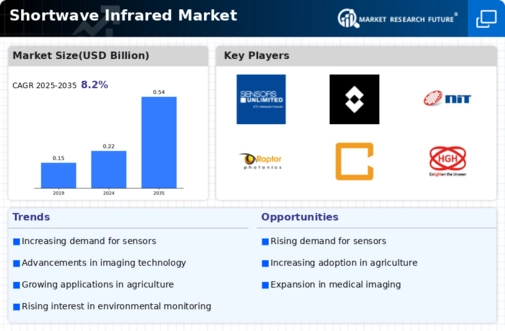Market Analysis
In-depth Analysis of Shortwave Infrared Market Industry Landscape
The dynamics of the Shortwave Infrared (SWIR) market are shaped by a variety of factors that collectively influence its growth and evolution. Technological advancements play a pivotal role in driving market dynamics. Continuous research and development efforts contribute to the improvement of SWIR sensors, making them more sensitive, efficient, and versatile. As the technology evolves, it opens up new possibilities for applications across diverse industries, fueling the demand for SWIR solutions.
Market demand is a significant driver of dynamics in the SWIR market. Various industries, including healthcare, manufacturing, defense, and agriculture, contribute to the demand for SWIR technology. The ability of SWIR sensors to provide valuable insights and imaging capabilities makes them indispensable in applications such as medical diagnostics, quality control, surveillance, and environmental monitoring. Understanding and responding to the evolving needs of these industries are crucial for businesses operating in the SWIR market.
Government policies and regulations also play a pivotal role in shaping market dynamics. Policies favoring the adoption of SWIR technology in defense and surveillance applications, as well as initiatives supporting its use in agriculture and environmental monitoring, influence market growth. Regulatory frameworks can either facilitate or impede the adoption of SWIR solutions, making it essential for businesses to navigate and comply with these regulations to thrive in the market.
The competitive landscape contributes to the dynamism of the SWIR market. The presence of key players, their market share, and strategic moves such as mergers, acquisitions, and partnerships impact the overall competitiveness. Companies that invest in innovation, establish strong market presence, and differentiate their offerings gain a competitive edge. This competition drives continuous improvement and innovation in SWIR technology, benefiting end-users with enhanced solutions.
Economic factors, including global economic conditions, also influence the dynamics of the SWIR market. Economic stability and growth contribute to increased investments in research and development, fostering technological innovation. Conversely, economic downturns may lead to a slowdown in investments, affecting the pace of technological advancements and market expansion. The cyclical nature of the economy necessitates adaptability and resilience for businesses operating in the SWIR market.
End-user industries significantly shape market dynamics. The specific needs and applications within sectors such as healthcare, manufacturing, and defense drive the development and adoption of SWIR solutions. For instance, the demand for SWIR technology in medical imaging or quality control processes in manufacturing propels market growth in these segments. Understanding the unique requirements of each industry is essential for businesses to align their offerings with market dynamics.
Environmental factors, including climate change and natural disasters, contribute to the dynamics of the SWIR market. The technology's utility in disaster management, environmental monitoring, and remote sensing positions it as a valuable tool in addressing challenges related to climate change and natural calamities. The increasing awareness of environmental issues amplifies the demand for SWIR technology in applications related to sustainability and conservation.











Leave a Comment